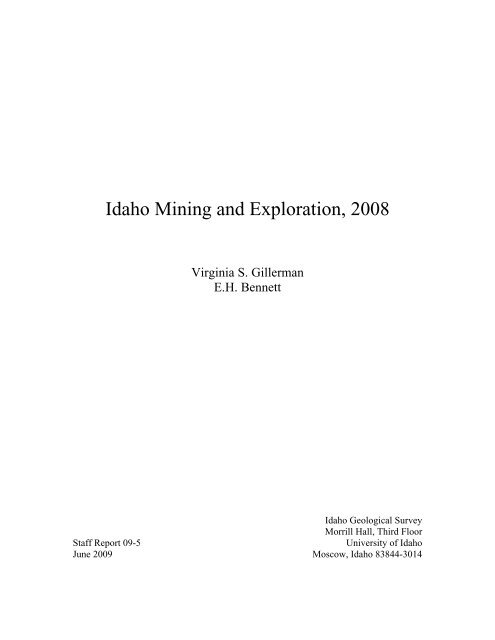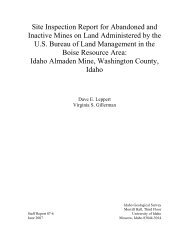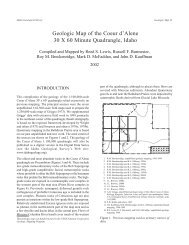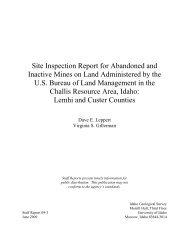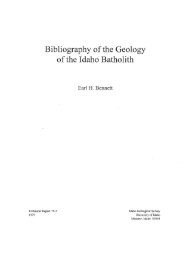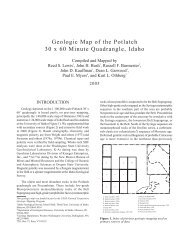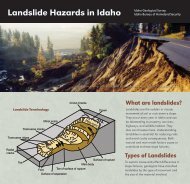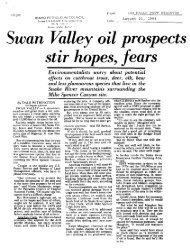IDAHO MINING AND EXPLORATION, 2008 - Idaho Geological Survey
IDAHO MINING AND EXPLORATION, 2008 - Idaho Geological Survey
IDAHO MINING AND EXPLORATION, 2008 - Idaho Geological Survey
Create successful ePaper yourself
Turn your PDF publications into a flip-book with our unique Google optimized e-Paper software.
<strong>Idaho</strong> Mining and Exploration, <strong>2008</strong><br />
Virginia S. Gillerman<br />
E.H. Bennett<br />
<strong>Idaho</strong> <strong>Geological</strong> <strong>Survey</strong><br />
Morrill Hall, Third Floor<br />
Staff Report 09-5<br />
University of <strong>Idaho</strong><br />
June 2009 Moscow, <strong>Idaho</strong> 83844-3014
<strong>Idaho</strong> Mining and Exploration, <strong>2008</strong><br />
Virginia S. Gillerman<br />
E.H. Bennett<br />
Staff Reports present timely information for<br />
public distribution. This publication may not<br />
conform to the agency’s standards.<br />
<strong>Idaho</strong> <strong>Geological</strong> <strong>Survey</strong><br />
Morrill Hall, Third Floor<br />
Staff Report 09-5<br />
University of <strong>Idaho</strong><br />
June 2009 Moscow, <strong>Idaho</strong> 83844-3014
Contents<br />
Metal Mining ......................................................... 1<br />
Phosphate Industry ..................................................... 3<br />
Other Industrial Minerals ................................................ 4<br />
Energy ............................................................... 5<br />
Exploration ........................................................... 5<br />
State Activities ........................................................ 8<br />
Illustrations<br />
Figure 1. <strong>Idaho</strong> non-fuel mineral production ................................. 9<br />
Figure 2. Commodity breakdown of USGS mineral<br />
value data for <strong>Idaho</strong> ............................................. 10<br />
Figure 3. Galena mine, Coeur d’Alene District, <strong>Idaho</strong> ......................... 11<br />
Figure 4. Agrium’s D pit at Dry Valley phosphate mine,<br />
Caribou County, <strong>Idaho</strong> ........................................... 11<br />
Figure 5. <strong>Idaho</strong> industrial minerals map for <strong>2008</strong>,<br />
not including phosphate .......................................... 12<br />
Figure 6. <strong>Idaho</strong> exploration map in <strong>2008</strong> ................................... 13<br />
Figure 7. Core drilling, Atlanta Gold, Elmore County, <strong>Idaho</strong> ................... 14<br />
Figure 8. Massive sulfide and skarn from Thunder Mountain Gold’s<br />
South Mountain property, Owyhee County, <strong>Idaho</strong> ...................... 14<br />
iii
<strong>IDAHO</strong> <strong>MINING</strong> <strong>AND</strong> <strong>EXPLORATION</strong>, <strong>2008</strong><br />
Virginia S. Gillerman, <strong>Idaho</strong> <strong>Geological</strong> <strong>Survey</strong><br />
E.H. Bennett, retired, <strong>Idaho</strong> <strong>Geological</strong> <strong>Survey</strong><br />
<strong>Idaho</strong>’s mining and exploration industry had a great first half of the year in <strong>2008</strong> with high<br />
commodity prices and buoyant optimism, but activity started to slowdown across-the-board in<br />
the fall as the nation’s economic downturn and tightening credit markets took its toll. In<br />
March, <strong>2008</strong>, the gold price topped $1,000 per troy ounce, silver neared $20 per ounce, and<br />
molybdenum took top honors as the state’s most valuable commodity with molybdenum oxide<br />
prices over $30 per pound for much of the year. By December, molybdenum oxide was under<br />
$10 per pound and the recession was in full swing. Precious metal prices have shown<br />
resilience as a hedge in uncertain times. Silver mining in north <strong>Idaho</strong> was hard hit as zinc and<br />
lead prices dropped 50% in the last half of <strong>2008</strong>. Construction activity, especially residential,<br />
was down for most of <strong>2008</strong>, and the aggregate-related commodities suffered accordingly.<br />
Employment in <strong>Idaho</strong>’s mining sector, which had been rising since its low point of 1,759 jobs<br />
in 2002, increased to nearly 2,800 jobs in <strong>2008</strong>, according to the <strong>Idaho</strong> Division of Financial<br />
Management. Unfortunately, it is projected to contract in 2009. The phosphate chemical<br />
plants in southeastern <strong>Idaho</strong> employ an additional 1000 plus people.<br />
Figure 1 shows <strong>Idaho</strong>’s non-fuel mineral production value, based on the latest revised data<br />
from the U.S. <strong>Geological</strong> <strong>Survey</strong>. Both the 2006 value of $779 million and the total for 2007<br />
of $790 million are down slightly from 2005’s revised record of $896 million. Preliminary<br />
estimates of <strong>2008</strong> production value indicate a substantial increase in value to $1.2 billion,<br />
principally due to substantial increases in the unit value of phosphate rock and unit value and<br />
quantity of molybdenum produced in <strong>2008</strong>. The USGS estimate for <strong>2008</strong> may be a bit<br />
optimistic given the downward prices at year’s end, but, overall, <strong>2008</strong> was excellent for metals<br />
and agricultural commodities, while construction materials may be down 25%. Figure 2 shows<br />
the commodity breakdown by percent of value in 2007 and projected for <strong>2008</strong>. Molybdenum is<br />
the state’s highest value commodity. Phosphate slightly trailed construction sand and gravel in<br />
2007 but will surpass it in value in <strong>2008</strong>. Overall, the percent of value from metals declined<br />
from 72% in 2005 to 54% in 2007.<br />
Metal Mining<br />
Miners and exploration geologists in the Coeur d’Alene district of Shoshone County<br />
maintained a frantic pace of activity, even after 120 years of mining and over 1.197 billion<br />
ounces of silver produced in <strong>Idaho</strong>’s famous Silver Valley. There seems to be no end to<br />
discoveries of rich silver-base metal veins and deposits in the Belt-age metasediments, though<br />
the mines are deep and costs high. Three mines were operating, though one, the Sunshine<br />
mine, was put back on care and maintenance during the year. Azteca let lapse their option on<br />
the Bunker Hill mine.
Hecla Mining produced most of their ore from the Gold Hunter Main, or 30, vein off the 5900<br />
level of the Lucky Friday mine at Mullan. The mine produced 2.9 million ounces of silver in<br />
<strong>2008</strong> at a cash cost of about $6 per ounce silver versus 3.1 million ounces in 2007 at a negative<br />
cash cost per ounce of $0.75 due to byproduct credits. The company was in the process of<br />
building for the future with a new tailings facility and mill upgrades. Planning for a deep shaft<br />
to access deeper levels was slowed at year’s end due to the economy. Exploration was<br />
successful in increasing reserves by 26% with drilling on the east and central portions of the<br />
vein system down to the 7100 level. Two of the main veins appear to coalesce into a thicker,<br />
high grade vein below the 6300 level. In addition, seven core holes were drilled in the “Gap”<br />
area above the active Gold Hunter mine and below the shallower, historic workings. Intercepts<br />
of multiple veins, some with ore grades and widths, proved the existence of mineralized<br />
structures within the previously unexplored 2,500-foot vertical zone. Hecla consolidated its<br />
district holdings with the purchase of the Independence Lead property near the Gold Hunter.<br />
Sterling Mining Company had reopened the Sunshine mine, the district’s largest single silver<br />
producer, in late 2007. They began production on the 3100 level and the Sterling Tunnel Upper<br />
Country access to the Sunshine vein. They also rehabilitated access to West Chance ores on<br />
the 2700 level. However, management changes in May and inability to obtain additional<br />
financing led to a suspension of production activities on September 16, <strong>2008</strong>. The mine<br />
remained closed for the remainder of the year, and over 100 employees lost their jobs. Sterling<br />
reported 179,240 ounces of silver produced in the first half of <strong>2008</strong>, but that was insufficient to<br />
fund mine operations and the debt load. The company continued care and maintenance through<br />
the remainder of the year.<br />
U.S. Silver achieved much of its goal of returning the Galena mine (Figure 3) to optimal<br />
production levels, producing over 1.2 million ounces of silver in the first three quarters before<br />
lower metal prices forced cutbacks in the fall. Mining focused on silver-lead ores off the 3000,<br />
3700, and 5200 levels. The mine completed over 15,000 feet of exploration and development<br />
drilling on newly discovered veins, including the high-grade 175 vein. Mine reserves have<br />
risen 60% since U.S. Silver took over the property. U.S. Silver reduced costs, and at year’s end<br />
decided to use the No.3 circuit of the Galena mill to process silver-lead ores, rather than the<br />
Coeur mill. Silver-copper ores are processed at the Galena, which was near its 900-tpd<br />
capacity by year’s end. The remaining repair of the Galena shaft, which had been concretelined<br />
from the 2400 level down to the 3000 level, was postponed due to the economy. In<br />
February, the Galena mill was awarded a MSHA Sentinels of Safety certificate for its<br />
outstanding record in 2006.<br />
New Jersey Mining Company continued development and minor gold production at their<br />
Golden Chest mine near Murray, just north of the main Coeur d’Alene district. Drifting<br />
intersected a pod of massive scheelite in one vein, and their North Ramp decline reached the #3<br />
level. The company installed an electrowinning cell at the concentrate leach plant at Kellogg in<br />
order to produce dore bars. In addition to the Golden Chest, New Jersey also completed<br />
surface facilities at the new No. 3 portal of the newly permitted Silver Strand mine east of<br />
Coeur d’Alene.<br />
2
Thompson Creek Metals mined Phase 6 ore all year at their huge Thompson Creek mine in<br />
Custer County and continued stripping on the Phase 7 pushback. Molybdenum prices remained<br />
high (over $30 per pound) until December, and the company started work on a new expansion<br />
mine plan; however, they were quick to react and cut back spending when prices fell to under<br />
$10 per pound in a matter of weeks. Production from the Thompson Creek mine in <strong>2008</strong> was<br />
16.765 million pounds of molybdenum oxide and high performance grade molybdenum<br />
disulfide, from 11.8 million tons of ore. The mine purchased four new Caterpillar haul trucks<br />
and updated the mine plan and resource base. They also installed a GroundProbe radar system<br />
to monitor for high wall failures and received the <strong>2008</strong> Bureau of Land Management’s<br />
Community Outreach and Economic Security Award.<br />
Reclamation work continued to make progress at Hecla’s closed Grouse Creek precious metal<br />
mine in central <strong>Idaho</strong> and at Kinross’ closed DeLamar and Stone Cabin mines in Owyhee<br />
County. The BLM and U.S. Forest Service continued to do physical safety closures and<br />
remediate hazards at inactive and abandoned mines and millsites such as the Buckhorn Mill<br />
south of Salmon, <strong>Idaho</strong>.<br />
Phosphate Industry<br />
Agricultural commodity prices soared in <strong>2008</strong>, partly due to ethanol subsidies and drought<br />
conditions that resulted in additional demand for grains and fertilizers. The result was an<br />
excellent year for <strong>Idaho</strong>’s phosphate industry. In addition to the three major mining and<br />
processing operations active in southeastern <strong>Idaho</strong>, there was new exploration by “outsiders.”<br />
Apatite-bearing ore beds in the Permian-age Phosphoria Formation host rock average about 25-<br />
30% P 2 O 5 , an enrichment of 130 times over the average value of the Earth’s crust. Ore from<br />
the black, organic-rich shales is processed in three <strong>Idaho</strong> plants, including the nation’s only<br />
elemental phosphorus facility. Each plant employs about 500 persons with additional<br />
personnel at the mines, making the phosphate industry one of the largest employers in the<br />
region.<br />
Monsanto continued to operate their elemental plant in Soda Springs to produce phosphorus for<br />
their Roundup herbicide. Over a million tons of ore is mined annually from their South<br />
Rasmussen Ridge mine, which is about halfway through its planned life. Concurrent<br />
reclamation was ongoing. Drilling was done within the pit and satellite areas, and at the<br />
Caldwell Canyon exploration property. Multi-agency permitting was underway on the<br />
proposed Blackfoot Bridge mine with extensive testing, modeling and environmental studies.<br />
A draft EIS is anticipated to be released by the BLM in the middle to latter part of 2009.<br />
J.R. Simplot Company operated the Don phosphoric acid fertilizer plant at Pocatello and mined<br />
ore from the large (> 2 million tons per year) Smoky Canyon operation near the Wyoming<br />
border. The mine was finishing Panel B, the last of previously approved mine panels. In June,<br />
the U.S. Forest Service released the Record of Decision and approval for expansion to Panels F<br />
and G. As expected, the decision was immediately appealed, and in November a judge rejected<br />
an injunction to stall the expansion. The new mine area is located in a roadless area that will<br />
require a contentious crossing over Sage Creek. Local communities joined Simplot to argue in<br />
3
favor of the 1,300-acre expansion which adds another 14 years of mine-life and preserves jobs.<br />
Pre-mine construction and road building will take about two years.<br />
Agrium, a publicly traded Canadian agricultural resources company with significant potash and<br />
phosphate operations, had an excellent year as prices for those commodities were more than<br />
double 2007 levels, though prices declined drastically in the fourth quarter of <strong>2008</strong>. Prices for<br />
phosphate fertilizer products, such as those produced at their plant in Conda with ore from the<br />
Dry Valley mine, peaked at $1,200/tonne, in the summer of <strong>2008</strong>, but dropped back to more<br />
typical levels of $400/tonne by the end of the year as the economic downturn and winter hit.<br />
Agrium was mining the D pit (Figure 4) and reclaiming the B pit at their Dry Valley mine; they<br />
received permission to reactivate operations next year at the Central/North Rasmussen Ridge<br />
mine.<br />
Rocky Mountain Resources Corp. drilled five holes and reviewed historical drilling (34 holes)<br />
by ESI on their Paris Hills phosphate and vanadium project near Paris, <strong>Idaho</strong>. They estimate an<br />
inferred resource of 120 million tons of 23% P 2 O 5 within a near-surface portion of the<br />
Phosphoria Formation. A vanadium-rich bed (0.79% V 2 O 5 plus phosphate) lies directly below<br />
the upper phosphate bed. This is the first phosphate exploration project by an outside company<br />
(i.e. not the large mine operators) in at least 20 years. However, vanadium was previously<br />
produced by Kerr-McGee in the early 1990’s using waste slag from Monsanto’s plant in Soda<br />
Springs. The Phosphoria Formation covers a wide region in <strong>Idaho</strong>, Utah, Wyoming and<br />
Montana; numerous old phosphate mines and prospects are listed in the <strong>Idaho</strong> <strong>Geological</strong><br />
<strong>Survey</strong> database.<br />
Other Industrial Minerals<br />
<strong>Idaho</strong> hosts a large variety of industrial minerals, many of which are in southern <strong>Idaho</strong>,<br />
including sand and gravel and crushed stone used for aggregate (Figure 5). Modest-sized<br />
industrial mineral operations are important for rural economies. Construction sand and gravel,<br />
used mainly for aggregate, was rumored to be down 30% or more, in line with national<br />
declines. Other commodities fared better but sales were starting to contract. True to its<br />
nickname of the “Gem State,” <strong>Idaho</strong> produced gem quality garnet in north <strong>Idaho</strong>, precious opal<br />
at Spencer, and jasper at several locations. Rock-hounding is a popular hobby, and a record<br />
6,500 visitors washed star garnets out of mud in newly remodeled sluice boxes at the U.S.<br />
Forest Service Garnet Dig near Fernwood.<br />
Emerald Creek Garnet, owned by WGI Heavy Minerals, had minor cutbacks and declining<br />
grades but continued to produce industrial garnets from two wash plants at their mine near<br />
Fernwood in northern <strong>Idaho</strong>. They changed from trommels to flat screens for greater efficiency<br />
and announced an extended winter shutdown at year’s end. WGI also sold off its interests in<br />
India but retained a distribution agreement.<br />
<strong>Idaho</strong>’s dimension stone operators include L and W Stone at the Three Rivers quarry near<br />
Clayton in Custer County, four producers of Oakley stone in Cassia County, and Table Rock<br />
Sandstone in Boise, plus smaller producers. Demand was down somewhat in the housing<br />
4
market. The Three Rivers quarry shipped about 10% less as they waited for their final<br />
environmental impact statement from the BLM. They experimented with staining the high wall<br />
to reduce visibility. Northern Stone Supply, Oakley Valley Stone, American Stone, and<br />
Scrivanich Natural Stone mined micaceous quartzite flagstone, known as Oakley stone, for a<br />
variety of construction and decorative applications. In <strong>Idaho</strong> Falls, <strong>Idaho</strong> Travertine was sold<br />
and renamed Rocky Mountain Travertine. In Boise, Hans Borbonus Landscaping operated the<br />
Table Rock Sandstone quarry. They used large saws and specialty machines to cut custom<br />
stone blocks for the <strong>Idaho</strong> Capitol Restoration, a $ 130 million project to add two underground<br />
wings and restore the historic building built 100 years ago of Table Rock sandstone.<br />
In eastern <strong>Idaho</strong>, Ash Grove Cement operated the cement plant at Inkom. Hess Pumice<br />
reported production down about 10% overall, with the cultured stone market down<br />
considerably. Hess mines pumice from the Wright’s Creek mine and processes it at their<br />
Malad plant. Other uses include abrasives, personal care, fillers, and horticulture. Hess also<br />
owns <strong>Idaho</strong> Minerals which mined perlite, largely for horticultural uses.<br />
Bear River Zeolite, a subsidiary of U.S.Antimony, expected <strong>2008</strong> sales to be up 50% over 2007<br />
thanks to an increased and diversified customer base. Bear River mines a large deposit of high<br />
purity zeolite just east of Preston, <strong>Idaho</strong>. They added a 60-inch vertical roller mill and made<br />
other plant improvements during the year.<br />
Energy<br />
U.S. Geothermal successfully operated their new 10 MW binary power plant at the Raft River<br />
geothermal project in Cassia County. They announced in October, an award from the U.S.<br />
Department of Energy (DOE) to demonstrate the viability of Enhanced Geothermal Systems<br />
(“EGS”) by using Raft River as a test site. DOE will provide up to $6 million cost-share as part<br />
of the $9 million effort.<br />
Exploration<br />
Mineral exploration activity was up in <strong>2008</strong> with a number of exciting projects (and a new<br />
discovery) around the state (Figure 6). Some projects shut down early as the financial credit<br />
crunch hit. Commodities of interest included precious metals, molybdenum, base metals,<br />
specialty metals, and industrials. In spite of favorable results on many projects, work plans for<br />
2009 will clearly be contingent on funding.<br />
In north <strong>Idaho</strong>, i-minerals focused on permitting and their feasibility study of the feldsparquartz<br />
deposit in the Bovill clay district in Latah County. In Bonner County, Shoshone Silver<br />
was hit with repairs for a snow-collapsed roof and county permit requirements at their<br />
Lakeview mill. They were processing base metal ores. They also struck a deal late in the year<br />
with Kimberly Gold Mines to acquire the Rescue mine at Warren.<br />
5
Azteca Gold Corporation, in a joint venture with Silver Royal Apex, drilled a deep hole and<br />
announced a new discovery at year’s end on their Two Mile project between Murray and<br />
Osburn in the fabulous Coeur d’Alene district. Azteca is the operator and drilled three core<br />
holes on the property in 2007, based on anomalies identified in Quantec’s Titan-24 distributed<br />
array geophysical survey. Starting in July, <strong>2008</strong>, Azteca collared DDH-005A as a deepening of<br />
a 2007 hole. It was completed in early December to a depth of 8,784 feet. Azteca reported that<br />
DDH-005A intersected disseminated mineralization starting at about 5,800 feet, deeper<br />
stockwork veining from 7,500 feet down, and finally massive sulfide mineralization up to 50<br />
feet thick near 7,950 feet depth. Mineralization continued to the final depth. A new vertical<br />
hole, DDH-006 and a wedge-off hole, DDH-005B, were started in December. Initial assays<br />
reported in January, 2009, included a massive zone of 15.5 feet (4.7 m) averaging 40% Zn,<br />
7.4% Pb, and 140.7 g/tonne Ag, ending at a depth of 7,953 feet in DDH-005A. These may be<br />
the deepest holes drilled in the district. Geologists have long looked to find a large source for<br />
the metals in the deep high-grade veins, and this is a truly exciting find. Host rock is<br />
presumably Precambrian Pritchard Formation, inviting comparisons to Sullivan-type ores,<br />
though few details are currently available. Drilling is continuing in 2009, and more<br />
information is on Azteca’s website.<br />
Hecla Mining Company also employed new technology in their Silver Valley regional<br />
exploration program. Geologists took 110 years of historic mine maps and had them digitized<br />
to create a 3D model of mine workings, including 245 mines and prospects, on Hecla’s lands in<br />
the district. Using special 3D projection techniques, geologists can generate new exploration<br />
targets and ideas. Mapping and sampling of strategic spots was underway.<br />
SNS Silver Corporation completed over 27,000 feet of surface drilling on the South and Upper<br />
Alhambra vein systems at the Crescent mine, just across Big Creek west of the Sunshine mine.<br />
In addition, they drilled 43,240 feet underground on 1,000-foot centers from the Hooper (main<br />
haulage) level of the mine. One intercept (SNS-1002) assayed 17 opt silver over 2 meters.<br />
Development drifting was done along the Alhambra vein with additional cross cuts to provide<br />
drill platforms. Rehabilitation of the Big Creek #4 or Alhambra level was also started, and<br />
mine transport equipment and ventilation were upgraded. Logging and assay results are being<br />
compiled into a resource estimate by SRK.<br />
New Jersey Mining Company had multiple project locations in north <strong>Idaho</strong> and staked new<br />
ones during the year. They drilled three holes on the Niagara Cu-Ag deposit, confirming<br />
grades of previous drilling and noting a weak gold anomaly. However, the main focus was<br />
gold in the Murray district. New Jersey has several properties up the East Fork of Eagle Creek,<br />
including the Gold Butte, Golden Reward, and Mineral Ridge claim blocks which are included<br />
in their 4,800-acre Toboggan joint venture with Newmont. Outcropping quartz with gold<br />
tellurides and potassic alteration and alkaline intrusives are some of the attractive signatures.<br />
Newmont’s work in <strong>2008</strong> included geologic mapping, rock and soil geochemistry, geophysics,<br />
and permitting for a drill program in 2009.<br />
Near Elk City, a joint venture of Premium Exploration and Clearwater Mining picked up the<br />
Buffalo Gulch and Petsite properties. Premium initiated discussions with the agencies for an<br />
EIS and new mine plan for the Buffalo Gulch deposit which Bema had permitted in 1990 as a<br />
6
100,000 ounce, oxide gold, open pit. The proposed mine will need to comply with <strong>Idaho</strong>’s<br />
newly revised cyanide regulations. Premium also controls the Petsite property, which is along<br />
the Orogrande shear zone where past drilling has returned several high grade intercepts and an<br />
inferred resource of over 500,000 ounces of gold.<br />
Formation Capital Corporation waited anxiously for a record of decision (ROD) by the<br />
Salmon-Challis National Forest on their <strong>Idaho</strong> Cobalt Project. The proposed underground<br />
cobalt-copper-gold mine is located in the historic Blackbird mining district of Lemhi County.<br />
A new feasibility study was positive, and it updated reserves (diluted, proven and probable) on<br />
the RAM deposit to 2.636 million tons @ 0.559% cobalt, 0.596% copper and 0.014 ounces per<br />
ton gold utilizing a 0.2% cobalt cut-off for a ten year mine life. In addition, there are inferred<br />
resources of 1.122 million tons and major exploration potential. The depressed economic<br />
climate adds to typical mine development financing concerns but also lowers construction costs<br />
and allows extra time for design and engineering work. The company went ahead with<br />
purchases of key mill equipment and key staff hiring. The ROD was issued in June and then<br />
remanded by the Forest Service for revisions. Formation has been negotiating with several<br />
environmental groups and reached agreements to resolve their concerns on water quality. The<br />
only appeal expected on issuance of the final ROD in early 2009 is that of other mining<br />
companies, including a major cobalt producer, in the Blackbird Mine Site Group, which was<br />
responsible for clean-up of the historic mine site.<br />
In other projects of north-central <strong>Idaho</strong>, Bear Lake Gold, a combination of Maximus Ventures<br />
and NFX Gold, picked up the Unity Mine at Warren from Unity Gold-Silver Mines, Inc. Bear<br />
Lake did 1,018 meters of surface drilling to test the extensions of the Little Giant and Rescue<br />
veins, which are narrow, but rich, gold-quartz veins cutting granodiorite. Faulting and drilling<br />
problems reportedly hampered the effort; though one intercept of over 4 g/t gold was reported.<br />
Journey Resources compiled past data from their Musgrove gold property in Lemhi County<br />
into a GIS database and a new NI 43-101 inferred mineral resource of 8 million tones at 1.22<br />
g/t gold. Some targets have not yet been drilled. Journey and Trio Gold also settled a legal<br />
dispute in March with the underlying owners of the Empire project near Mackay and released<br />
all interest in the Empire deposit.<br />
Thorium Energy, Inc. staked claims and did additional sampling at their Lemhi Pass and<br />
Diamond Creek properties which host some of the nation’s largest thorium and rare earth<br />
resources. Interest has been peaked by renewed global interest in thorium fuel cycles and the<br />
rare earth market, currently controlled by China. The Lemhi Pass district straddles the<br />
Continental Divide in <strong>Idaho</strong> and Montana.<br />
Gentor Resources, Inc. completed 21,000 feet of drilling on the molybdenum-tungsten-silver<br />
deposit at the private Ima mine near Patterson in remote Lemhi County. They announced an<br />
inferred mineral resource estimate of 5.7 million tons grading 0.15% Mo overall. Lack of<br />
funds terminated the drill program in May. Angle hole 30 intersected the deep granite at 1702<br />
feet depth, and the first 368 feet into the granite averaged 0.28% MoS 2 with a silver credit.<br />
Also in eastern <strong>Idaho</strong>, Otis Capital drilled at the Kilgore gold target in Clark County, and Doe<br />
Run Mining drilled a lead prospect at Birch Creek.<br />
7
Mosquito Consolidated Gold Mines, Ltd. drilled 11 diamond core holes, totaling over 26,700<br />
feet, on the giant CUMO molybdenum-copper deposit in Boise County in southwestern <strong>Idaho</strong>.<br />
Two of the holes were terminated early due to winter and two others due to faulting.<br />
Mineralization in the porphyry complex starts near surface and is quite continuous over a large<br />
vertical and horizontal extent. Assay results for Hole 39-08, the best yet on the property, were<br />
2378 feet (724m) of 0.101 % MoS 2 and 0.05% Cu, and the hole ended in mineralization at a<br />
fault zone. Results were being compiled at year’s end. Initial metallurgical reports were<br />
favorable. Geologic work has shown a definite and traceable metal zoning pattern with an<br />
upper Cu-Ag zone, then a Cu-Mo shell around the Mo zone. The deposit was originally<br />
discovered by Amax Exploration in 1963.<br />
Southern <strong>Idaho</strong> precious metal projects included Hell and High Water’s development work on a<br />
“high gravel placer” in Boise County; Hydrothermal Metals’ exploration in the Raft River<br />
geothermal area; Freegold Ventures’ work at the <strong>Idaho</strong>-Almaden hot spring, gold-mercury<br />
deposit in Washington County; Otis Capital’s drilling of the Milestone hot spring property in<br />
Owyhee County; and Silver Falcon’s attempt to mill waste dumps and tailings from War Eagle<br />
Mountain in Owyhee County.<br />
Atlanta Gold Corporation revised their plan for development of the Atlanta gold-silver project<br />
in Elmore County. Due to local concerns about cyanide and the original bulk mining, open pit<br />
mine plan, Atlanta refocused early in <strong>2008</strong> on an underground mine and mini-pit scenario with<br />
non-cyanide milling on-site. The company drilled 57 holes (Figure 7) to test the eastern pit<br />
area and extensions of the Monarch shear zone at surface and underground. They also did 25<br />
surface trenches, encountering the mineralized shear in 22 of them and ore grade gold in many.<br />
Contractors started a new portal, the Monarch Decline, but were having problems with bad<br />
ground. The new mine plan will be designed for more selective mining and reducing the<br />
environmental footprint. Results of <strong>2008</strong> work were being compiled for an updated NI 43-101<br />
report and additional work in 2009.<br />
Thunder Mountain Gold drilled two core holes at their South Mountain property in Owyhee<br />
County, intersecting skarn and massive sulfide similar to that mined on the Sonneman and<br />
Laxey levels. A 17.5-foot intercept in hole DMEA-2 assayed 0.129 ounces/ton gold with<br />
significant Ag, Zn, Cu and Pb; while an upper zone assayed over 7.7% zinc with other metal<br />
credits in well-mineralized skarn (Figure 8). The company also did reconnaissance work and<br />
plans additional exploration in 2009.<br />
State Activities<br />
The <strong>Idaho</strong> <strong>Geological</strong> <strong>Survey</strong> (IGS) put out 17 new publications in <strong>2008</strong>. The <strong>Survey</strong> also is<br />
nearing completion on a major effort to scan and post online most of the old IGS or IBMG<br />
(<strong>Idaho</strong> Bureau of Mines and Geology) publications. Over 500 publications and over 330<br />
geologic maps are now downloadable at www.idahogeology.org. Other activities during the<br />
year included the annual teacher workshop, new USGS Statemap-sponsored geologic mapping,<br />
and research on geology and geochronology of the Lemhi Pass thorium and rare earth deposits.<br />
8
The final technical report by Virginia Gillerman for the Lemhi Pass USGS MRERP grant is<br />
available on the USGS website.<br />
ILLUSTRATIONS<br />
<strong>Idaho</strong> Non-fuel Mineral Production (USGS)<br />
Million $<br />
1400<br />
1200<br />
1000<br />
800<br />
600<br />
400<br />
200<br />
0<br />
2000 2001 2002 2003 2004 2005 2006 2007 <strong>2008</strong>p<br />
Con. S & G Silver Moly TOTAL<br />
Figure 1. <strong>Idaho</strong> non-fuel mineral production.<br />
9
<strong>Idaho</strong> 2007 final: $ 790 million<br />
<strong>Idaho</strong> <strong>2008</strong> preliminary: $ 1.2 Billion<br />
Con. S& G Crush Stone Phosphate Other Industrials<br />
Base Metals Silver+(Au) Molybdenum<br />
Figure 2. Commodity breakdown of USGS mineral value data for <strong>Idaho</strong>.<br />
10
Figure 3. Galena mine, Coeur d’Alene District, <strong>Idaho</strong>.<br />
Figure 4. Agrium’s D pit at Dry Valley phosphate mine, Caribou County, <strong>Idaho</strong>.<br />
11
Figure 5. <strong>Idaho</strong> industrial minerals map for <strong>2008</strong>, not including phosphate.<br />
12
Figure 6. <strong>Idaho</strong> exploration map in <strong>2008</strong>.<br />
13
Figure 7. Core drilling, Atlanta Gold, Elmore County, <strong>Idaho</strong>.<br />
Figure 8. Massive sulfide and skarn from Thunder Mountain Gold’s South Mountain property,<br />
Owyhee County, <strong>Idaho</strong>.<br />
14


